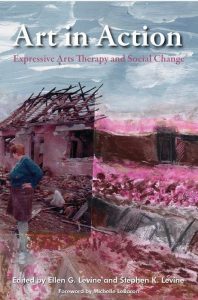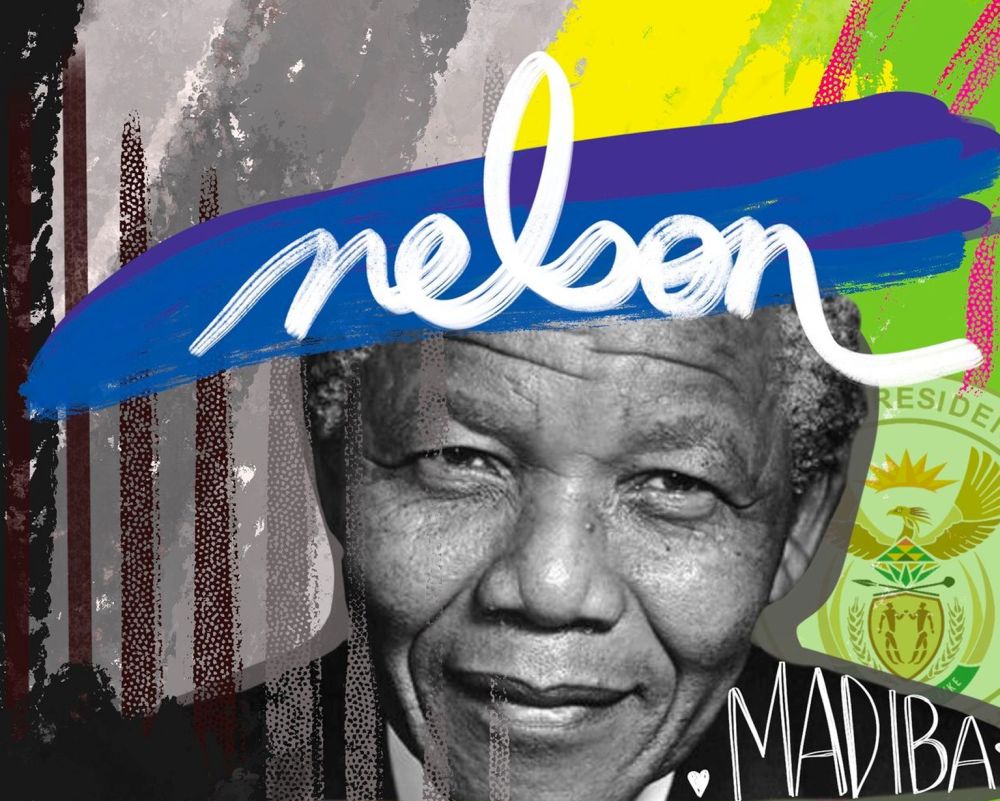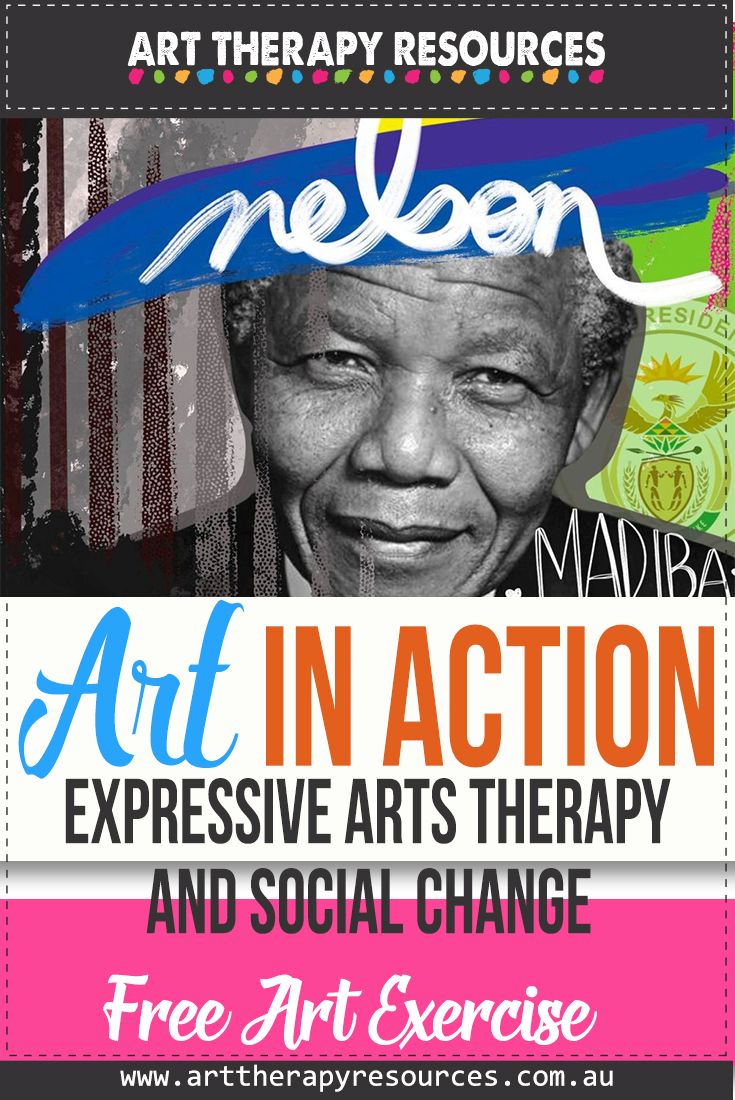THIS POST INCLUDES:
1. Art in Action: Expressive Arts Therapy and Social Change
2. A review
3. Art Therapy Exercise
Art in Action: Expressive Arts Therapy and Social Change
Author: Ellen G. Levine
Date published: 2011
Page length: 240

Amazon purchase link: Art in Action: Expressive Arts Therapy and Social Change
ABOUT THE BOOK
About the book (from the publisher):
The field of expressive arts is closely tied to the work of therapeutic change. As well as being beneficial for the individual or small group, expressive arts therapy has the potential for a much wider therapeutic impact.
This book addresses how the principles and practice of the arts therapies can be and have been used successfully to inspire social action and bring about social change across the globe. The contributors explore the transformative power of arts therapies in areas stricken by conflict, political unrest, poverty or natural disaster. They look at how and why expressive arts works, and how it can be used to engage social consciousness and improve social conditions, taking into account the issues that arise within different contexts and with different populations.
Leading expressive arts therapy practitioners give inspiring accounts of social projects they have worked on, from using poetry as a means of trauma intervention with Iraqi survivors of war and torture, to setting up storytelling workshops to aid the integration of Ethiopian Jewish immigrants in Israel.
Offering visionary perspectives on the role of the arts in inspiring change at the community or social level, this is an important book for all students and practitioners of creative and expressive arts therapies, as well as psychotherapists, counsellors and others working to effect social change.
Book Content:
Part I Principles
1. Art Opens to the World: Expressive Arts and Social Action (Stephen K. Levine)
2. From Social Change to Art Therapy and Back Again: A Memoir (Ellen Levine)
3. Social Activism within Expressive Arts “Therapy”: What’s in a Name? (Karen Estrella)
4. Communal Art-making and Conflict Transformation (Paolo J. Knill)
5. From the Studio to the World: How Expressive Arts Therapy Can Help Further Social Change (Shaun McNiff)
Part II Issues
6. A Social–Critical Reading of Indigenous Women’s Art: The Use of Visual Data to “Show,” rather than “Tell,” of the Intersection of Different Layers of Oppression (Ephrat Huss)
7. Inside-Out Outside-In: Found Objects and Portable Studio (Debra Kalmanowitz and Bobby Lloyd)
8. From Private Pain Toward Public Speech: Poetry Therapy with Iraqi Survivors of Torture and War (Shanee Stepakoff, Samer Hussein, Mariam Al-Salahat, Insherah Musa, Moath Asfoor, Eman Al-Houdali, and Maysa Al-Hmouz)
Part III Projects
9. The Choreography of Absence: (In)habiting the Imagination after War (Carrie MacLeod)
10. Creating Space for Change: The Use of Expressive Arts with Vulnerable Children and Women Prisoners in Sub-Saharan Africa (Gloria Simoneaux)
11. Beauty in the Rough Places (Karen Abbs)
12. Art as a Gift: Expressive Arts in Bolivia (Sally S. Atkins)
13. A Black Dog on a Green Meadow: Doing Expressive Arts Therapy in Peru: Some Headlines (TAE Perú Judith Alalu, Jose Miguel Calderon, Ximena Maurial, Monica Prado, Martin Zavala)
14. These Stories are Burning a Hole in my Brain: Using the Arts to Tell the Stories of the Ethiopian Jewish Immigrant Community in Israel (Vivien Marcow Speiser and Samuel Schwartz)
A REVIEW OF INTRODUCTION TO ART THERAPY
This book is a collection of contributing authors providing insight and their perspectives on how to use expressive arts to enact and explore social change.
The cross-range of contributors helps to build a diverse point of view of how expressive arts can interact with social change. When social change can mean different things to a variety of people, it is useful to have a range of voices contributing to this topic.
This book provides insight into developing community-based projects that foster communal perspectives. It also provides insight into the negative aspects of conflict and how expressive arts can provide a bridge to encourage resolution and acceptance in areas of disagreement and conflict.
The book is presented in three main sections including principles, issues, and projects. The section focusing on principles presents an overview of how arts can benefit areas of conflict by introducing alternative viewpoints of a situation and experience.
The other section sections (issues and projects) cover a range of projects that involves a variety of expressive arts techniques such as visual art, dance, music, drama, and writing to name a few. The projects show a wide variety of experiences where art can benefit groups of participants with shared experiences and feelings.
The exercises help develop connections between participants as well as provide insight into a wider view of how difficulties can be perceived from alternative points of view. Arts can help foster communal experiences as well as promote healing amongst various groups that may be experiencing conflict.
This book covers material that helps the reader understand the theoretical aspects of expressive arts and social change as well as providing helpful practical steps in using expressive arts to foster social change. The numerous examples included in the book are evidence of the effective nature of expressive arts therapy.
ART THERAPY EXERCISE

We have included an example exercise from the book. This exercise is featured in chapter 10, Creating Space for Change: The Use of Expressive Arts with Vulnerable Children and Women Prisoners in Sub-Saharan Africa by Gloria Simoneaux.
Gloria lists a number of examples of exercises she undertook with participants in her group. The below exercise is developed using one of the types of exercises:
Draw someone who had a sad thing happen but had the strength to move on.
OUTCOME: The painting below represents Nelson Mandela who was imprisoned for most of his adult life but then eventually became the President of South Africa. The photo represents the change from left to right where the dark stripes represent Mandela in prison and then the right side evolving into colour as he became the President of his country.
Purchase: If this book sounds interesting to you, it can be purchased from Amazon. You can also view the contents pages and a few of the introductory chapters in the sample.
BUILD YOUR ART THERAPY REFERENCE MATERIALS:
Pin this image to your Pinterest board.

SHARE KNOWLEDGE & PASS IT ON:
If you’ve enjoyed this post, please share it on Facebook, Twitter, Pinterest. Thank you!
